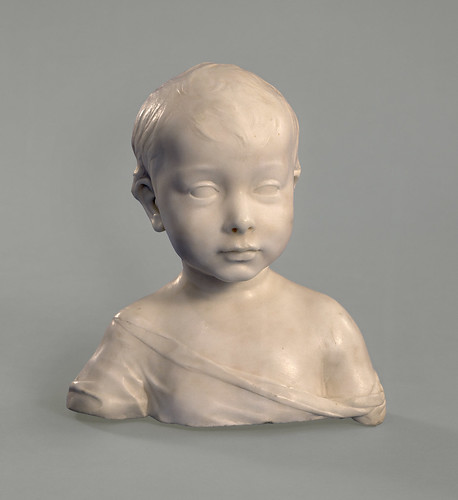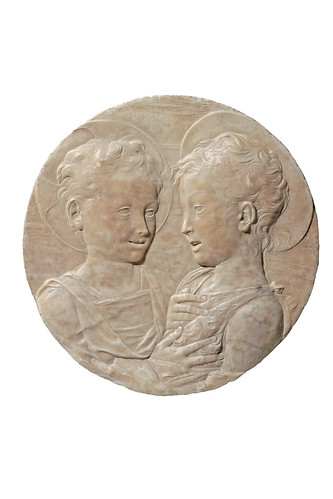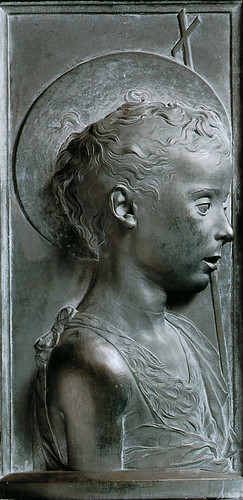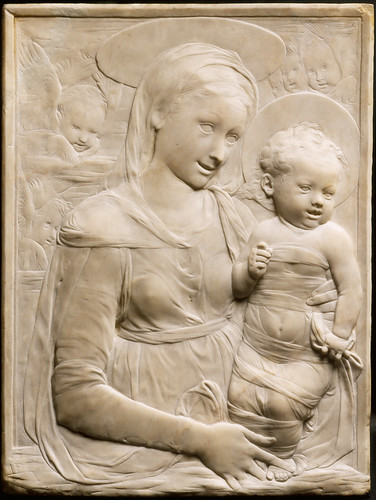Post by Andrea Kirsh

Cat. No. 9 | File Name: 248-016.jpg
Desiderio da Settignano (c. 1429 – 1464)
Laughing Boy, c. 1460-1464
marble
Kunsthistorisches Museum, Vienna, Bequest of Gustav Benda
Old master sculpture exhibitions are rare; fifteenth-century sculpture exhibitions almost unheard of. This is just one reason to go to the National Gallery of Art to see “Desiderio da Settignano: Sculptor of Renaissance Florence”. The exhibition was organized jointly with the Louvre and the Bargello Museum in Florence, where it has already been seen. If the only Donatello you know of is a Ninja turtle, you shouldn’t be put off. The exhibition is small: twenty three works, which allows for close study, and twenty of them depict either babies, adolescents, or the Madonna and Child and can easily be appreciated by anyone who enjoys sculpture. The pieces are intimate, like lieder or chamber music, with none of the operatic grandeur of sculpture intended for churches or civic plazas.

Philadelphia visitors can take pride in the PMA’s loan of a Madonna and Child relief, know as the “Foule Madonna” after a nineteenth-century owner. It’s one of five versions on view, and the organizers obviously thought highly of it, as they used it for the catalogue’s cover.
Desiderio was in the generation following Donatello, and the exhibition includes a domestic altarpiece for which Donatello created the Madonna and Child in gilt bronze, and Desiderio carved the marble surrounding frame. While he doesn’t have the gravitas or inventiveness of Donatello, Desiderio’s facility with the chisel was unsurpassed, and his ability to capture a life-like image and represent a range of delicate fabrics would influence Leonardo and Michelangelo. On the sculptor’s tomb it records that he “brought cold marble to life.”

Cat. No. 12 | File Name: 248-012.jpg
Desiderio da Settignano (c. 1429 – 1464)
Christ and Saint John the Baptist as Children (The Arconati Visconti Tondo), c. 1455-1457
marble
Musée du Louvre, Département des Sculptures, Paris, Gift of Marquise Gian-Martino Arconati Visconti, 1916
The altarpiece by Donatello, mentioned above, is in the courtyard just outside the galleries, as is a reliquary attributed to an unknown sculptor in Desiderio’s circle: an almost life-sized bust portrait of St. Constance, made of wood with full polychrome (or multi-color paintwork, in realistic colors here). I was delighted to see so much surviving paint; it gives a good idea of the original appearance of the many medieval and Renaissance sculptures that have lost their painted surfaces.

Cat. No. 13 | File Name: 248-006.jpg
Desiderio da Settignano (c. 1429 – 1464)
The Young Saint John the Baptist, c. 1450-1453
pietra serena with traces of polychromy
Museo Nazionale del Bargello, Polo Museale Fiorentino, Florence
Entering the first gallery you come upon three marble busts of slender, long-necked adolescents: a youthful St. John the Baptist and an unidentified boy and girl. She’s in her mid-teens, which was considered appropriate for marriage, so this may be a wedding portrait (as were many painted portraits which the sculpture resembles, such as the Scheggia “Portrait of a Lady” at the PMA, or the Pollaiuolo at the Metropolitan Museum of Art, both visible on-line). We can see every detail of her dress and hair-do: she wears a blouse of light fabric which is gathered at the neckline beneath her stiff bodice. Her wavy hair is bound up with both ribbons and a piece of fabric, from which one hank of hair escapes and falls fetchingly over her left shoulder.

Cat. No. 19 | File Name: 248-020.jpg
Desiderio da Settignano (c. 1429 – 1464)
Madonna and Child (The Foulc Madonna), c. 1460
marble
Philadelphia Museum of Art. Purchased with the W.P. Wilstach Fund from the Edmond Foulc Collection, 1930
The star of the first room is certainly the tondo (round) relief of Christ and St. John the Baptist as Children, lent by the Louvre. It’s the only work here in a colored marble, and it’s the hue of pale honey. The fineness of the relief carving is wondrous, but even more remarkable is its emotional charge: Christ reaches with his right hand and places it on John’s camel-skin garment, just over his heart. This is an illustration not of two children, but of their bond.
The second room of the exhibition has the series of Madonna and Child reliefs and a remarkable relief of St. Jerome where Desiderio seems to have drawn as much as carved with the chisel (and he didn’t polish out all the chisel marks, thus leaving a record of his handwork). There’s also a group for which the artist was famous, images of very young boys. Several of these are variants of the standing infant Christ that served as the finial for a funerary monument. But the three busts of infants are something else: certainly done from life, even if intended to represent religious figures. Desiderio may actually have invented this sculptural type. It’s famously hard to represent the unformed features of babies, and harder still to avoid sentimentality. Desiderio’s bambini are timeless and real. One of them laughs. No one would model such moving children again for more than four hundred years, when Medardo Rosso took up the subject.
[Ed note: This exhibit closes Oct. 8. We apologize for not getting the post up in a timely fashion but think the commentary and images are great, so we are posting it, even though the opportunity to see the show is over.]
–Andrea Kirsh is an art historian based in Philadelphia. You can read her recent Philadelphia Introductions articles at inLiquid.









